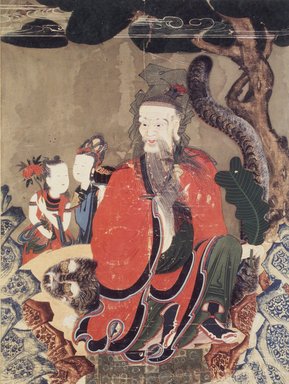
Medium: Ink and color on silk
Geograhical Locations:
Dates:19th century
Dimensions: Image: 34 x 24 1/2 in. (86.4 x 62.2 cm) Overall: 43 1/4 x 34 1/2 in. (109.9 x 87.6 cm)
Collections:
Accession Number: 84.145
Image: 84.145.jpg,
Catalogue Description: Image of an elderly sage seated on a tiger in a mountain setting (represented by stylized rock forms). The figure is attended by two young servants. Koreans have worshipped mountains as supernatural spirits since ancient times. Initially, the mountain itself was represented as a divine image; this identity was later transferred to the image of a tiger, a powerfully symbolic animal and inhabitant of the high terrain of Korea. Eventually, the deity of the mountains was symbolized as an old man accompanied by a tiger. This figure was known in the Shamanist pantheon as the Mountain Spirit, or Sanshin. As a Shamanist deity, the Mountain Spirit embodied abundance and fertility. When integrated into Buddhism, he became the patron spirit who would deliver babies and protect them from misfortune. Most Korean Buddhist temples have a separate shrine containing images dedicated to the local Mountain Spirit. In this image, the Mountain Spirit is mounted on a tiger in a three-quarter view and wears a red Chinese official robe. Two nymphs stand in the background. They are depicted in a slightly smaller scale to emphasize the prominence of the deity at the center, a common pictorial practice in Korean folk painting to express hierarchy. This painting is executed in bright reds, yellows, greens, and blues, and with little modeling and use of perspective- attributes typical of folk paintings depicting this subject matter. Hyunsoo Woo From "Journey Through Asia" catalogue, 2003. Buddhist paintings called Sansindo ("Painting of Mountain God") portray a personified tiger that the common people worshipped as a mountain god. Sansindo were enshrined in Sansingak (Halls of Mountain God), Sanwanggak (Halls of Mountain King), or Sanseonggak (Halls of Three Holy Beings). Most of the extant paintings depicting the mountain god made as objects of worship were made in the nineteenth century, when the overlap of Buddhism and folk religion reached its peak. In this particular painting, the mountain god appears as an old man with a long white beard, seating on a tiger, which is crouched under a pine tree against a backdrop of deep valleys and oddly-shaped rocks. Beyond the crest of the hill where the mountain king is seated peonies blossom and young attendants offer food. The god is wearing an official's vermillion robe and a black cloth headdress. He has a somewhat stern look, and holds a banana leaf fan in his left hand and a vase with the "herb of immortality" in his right. Certain features, such as the god's small mouth, rocks depicted in a highly conventionalized style, transparent clouds flowing between pine branches, and rigid brush strokes reveal that this is a work painted in the nineteenth century. From "Korean Art Collection in the Brooklyn Museum" catalogue.